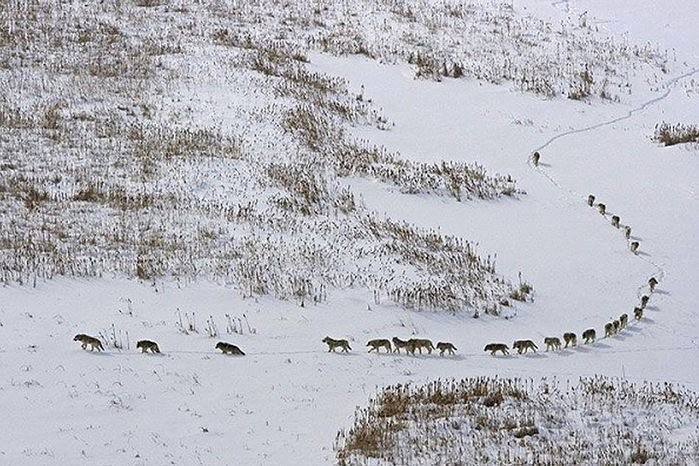In December 2015, a photograph of a wolf pack marching through the snow began circulating via Facebook along with an inaccurate description about its hierarchy:
"A wolf pack: the first 3 are the old or sick, they give the pace to the entire pack. If it was the other way round, they would be left behind, losing contact with the pack. In case of an ambush they would be sacrificed. Then come 5 strong ones, the front line. In the center are the rest of the pack members, then the 5 strongest following. Last is alone, the alpha. He controls everything from the rear. In that position he can see everything, decide the direction. He sees all of the pack. The pack moves according to the elders pace and help each other, watch each other."
Despite the image's popularity, however, the attached description of the inner workings of a wolf pack are inaccurate.
The photograph shown was taken by Chadden Hunter and featured in the BBC documentary Frozen Planet in 2011, with its original description explaining that the "alpha female" led the pack and that the rest of the wolves followed in her tracks in order to save energy:
A massive pack of 25 timberwolves hunting bison on the Arctic circle in northern Canada. In mid-winter in Wood Buffalo National Park temperatures hover around -40°C. The wolf pack, led by the alpha female, travel single-file through the deep snow to save energy. The size of the pack is a sign of how rich their prey base is during winter when the bison are more restricted by poor feeding and deep snow. The wolf packs in this National Park are the only wolves in the world that specialize in hunting bison ten times their size. They have grown to be the largest and most powerful wolves on earth.
While this description is more accurate than the one shared in the viral Facebook post, some researchers would nonetheless dispute the use of the term "alpha." In David Mech's 1999 paper "Alpha Status, Dominance, and Division of Labor in Wolf Packs," he argued that the concept of an "alpha" wolf who asserts his or her dominance over other pack members doesn't actually exist in the wild:
Labeling a high-ranking wolf alpha emphasizes its rank in a dominance hierarchy. However, in natural wolf packs, the alpha male or female are merely the breeding animals, the parents of the pack, and dominance contests with other wolves are rare, if they exist at all. During my 13 summers observing the Ellesmere Island pack, I saw none.
Thus, calling a wolf an alpha is usually no more appropriate than referring to a human parent or a doe deer as an alpha. Any parent is dominant to its young offspring, so "alpha" adds no information. Why not refer to an alpha female as the female parent, the breeding female, the matriarch, or simply the mother? Such a designation emphasizes not the animal's dominant status, which is trivial information, but its role as pack progenitor, which is critical information.
This photograph is "real" in the sense that it shows a pack of wolves in Wood Buffalo National Park, but the pack is not being led by the three oldest members and trailed by an "alpha" wolf, as implied by a viral Facebook post. Instead, one of the stronger animals leads the group in order to create a path through the snow for them.

